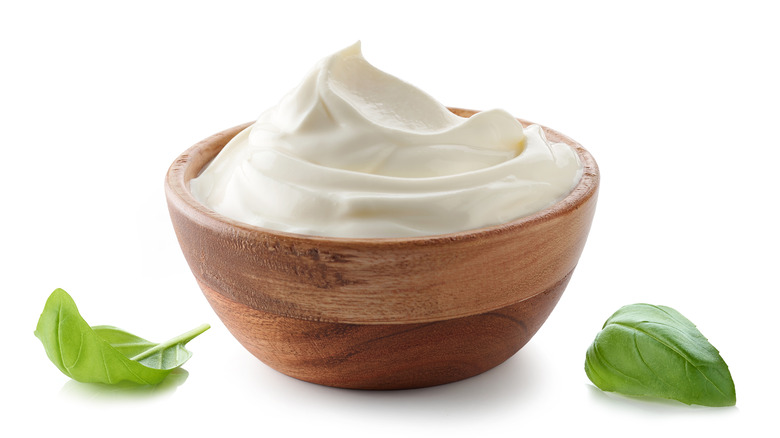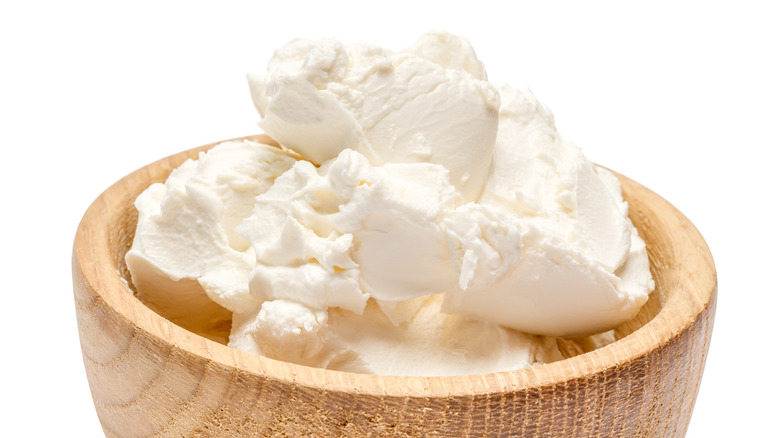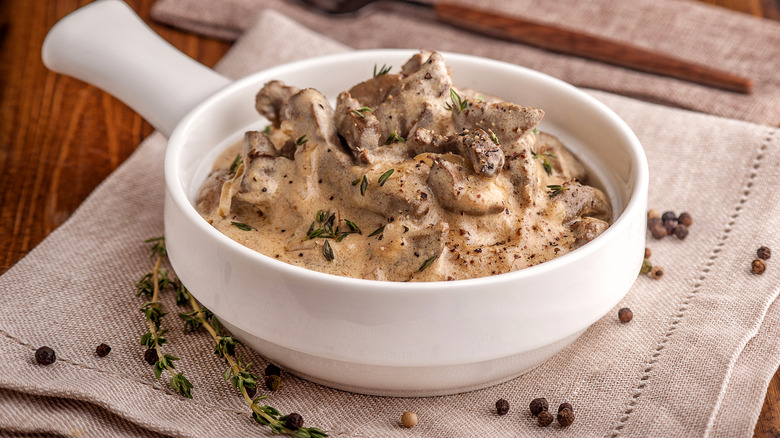Crème Fraîche Vs. Sour Cream: What's The Difference?
Similar in appearance, use, and taste, sour cream, and crème fraîche may be confused for each other, but they have important differences. With the fancier-sounding name of the two, crème fraîche means fresh cream in French, per MasterClass. Its tangy and nutty taste has made it a popular condiment in France and beyond. In addition to being used as a condiment, crème fraîche is a common addition to appetizers, dinners, and desserts.
As its name implies, sour cream has a slightly sour taste, but it's still used in various sweet and savory recipes. Epicurious suggests incorporating the dairy product in treats like banana bread and cheesecake and entrées such as chicken kebabs and pasta bakes. Like crème fraîche, sour cream traces its origins to Eastern Europe, and can be found in many dishes native to the area, says MasterClass. Of the two, crème fraîche and sour cream, the latter is the more commonly available in the U.S.
Creamy and nutty crème fraîche
While sour cream and crème fraîche both have a sour taste, according to Food Network, crème fraîche is less tangy and has a creamier texture. Crème fraîche is made completely of buttermilk and heavy cream, and contains 36% to 40% butterfat. This amount of fat allows crème fraîche to remain stable and not curdle when it is incorporated into hot dishes, such as soups and sauces. With lower fat content, sour cream and yogurt cannot be used the same way. Incorporate them into a hot dish, and they are likely to curdle, but adding them after a dish has been prepared is fine.
Crème fraîche can be easily swapped for its Mexican cousin, crema in dishes like tacos and enchiladas. The reason crème fraîche makes for a better substitute than sour cream is that, like crema, it's thin enough to drizzle. But crème fraîche's traditional uses are in carrot soup, mussels, and potato latkes (via Food & Wine).
A dollop of sour cream
Homemade sour cream involves only three ingredients: milk, heavy cream, and distilled white vinegar, according to Allrecipes. To make a fermented rather than acidified sour cream, cream with at least 18% milkfat must be blended with a lactic acid bacterial culture (via California Dairy). The cream is thickened and develops its signature sour flavor when left to incubate at room temperature. Once it's how you like it, you can then use it to top your baked potatoes and chili.
Sour cream is sold in both regular and light versions, the latter being from cultured cream and skim milk, according to Food Network. Though it sounds more decadent, crème fraîche has less fat than sour cream but is higher in protein, according to Taste of Home. But sour cream's thicker consistency works great with heavier dishes like beef stroganoff and borscht, which, SPICEography says, can't be properly made without it.
Swapping sour cream and crème fraîche
While sour cream and crème fraîche have subtle differences in taste and consistency, they can sometimes be substituted for each other. Food Network suggests adding a little lemon juice or white wine vinegar to crème fraîche to match sour cream's tartness. Crème fraîche will work great with anything hot, so putting it on chili or baked potatoes, as you would sour cream, will work in a pinch. The French cultured cream, because it has a more neutral flavor, is well suited to baked goods, even if sour cream is what is called for.
Sour cream can't be used instead of crème fraîche in recipes as easily, per Allrecipes. As mentioned, if a cream needs to be added while cooking, sour cream is an unsuitable swap as it will curdle. Just remember that crème fraîche is not as sour as sour cream, so don't swap them carelessly. But as simply an airy dairy topping, the two can typically be changed out for one another, and both are guaranteed to add some extra deliciousness to whatever is being prepared.



